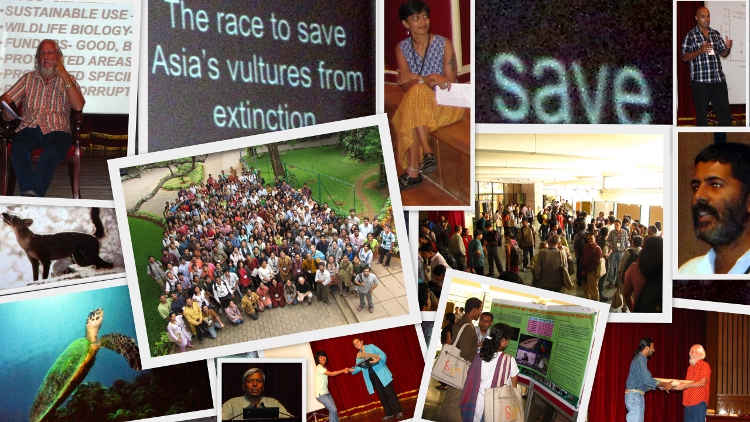Conservationists meet
The University of Cambridge has conducted the 'Student Conference on Conservation Science' (SCCS) since the year 2000 in order to provide a platform for emerging ecologists and conservationists around the world to meet, and discuss current issues in conservation with experts in the field. The year 2010 saw the first edition of the Indian chapter, named SCCS-Bangalore (www.sccs-bng.org), which, like its Cambridge counterpart, focused on student participation and training by means of presentations, workshops and discussions. Four years of planning by Suhel Quader from NCBS, Raman Sukumar from IISc and others culminated in an event hosting about 320 participants including 20 oral presentations and 46 posters. Additional events included panel discussions on controversial issues, and a session called “Who's Who in Conservation”, where representatives from different conservation-related organisations interacted with participants.
Student Presentations and Plenary Talks
A wide range of conservation research was highlighted by students ranging from hornbills in Arunachal Pradesh and gharials in Bangladesh to vultures in Asia. The presentations revolved around the themes of conservation biology, conservation and human communities, mammal conservation, species interactions, genetics, and landscape ecology. Studies on habitat selection by wolves in agricultural landscapes of Solapur, Maharashtra; estimation of the density of tigers and their prey preferences in Rajiv Gandhi Orang National Park in Assam; bat communities in a highly fragmented landscape in Anamalai Hills, Western Ghats, the impact of cane toads on freshwater crocodiles in Lake Argyle, Australia, were some of the topics discussed by the students.
Among the plenary speakers, Harini Nagendra (Ashoka Trust for Research in Ecology and the Environment, Bangalore) emphasized the need of collective action in conservation. Rhys Green (University of Cambridge, UK) described the scientific detective story that led to the discovery of the catastrophic effect that the non-steroidal anti-inflammatory drug, diclofenac had on South Asian vulture populations, and the subsequent conservation measures. Ruth DeFries (Columbia University, USA) talked about ecological linkages between protected areas and the surrounding human-dominated landscapes. Romulus Whitaker (Agume Rainforest Research Station) challenged participants' philosophical and ethical stands in conservation science.
Panel Discussions
Panelists, R. Sukumar (Indian Institute of Science), M. D. Madhusudan (Nature Conservation Foundation, Mysore), Ullas Karanth (Wildlife Conservation Society) and T. R. Shankar Raman (Nature Conservation Foundation, Mysore) discussed the controversy surrounding the need for protected areas. The discussion led to a suggestion that conservation efforts should engage the public, link the corridors, and encourage scientists to work in areas where activities such as mining are carried out.
Janaki Lenin (Draco-India), Anindya Sinha (National Institute of Advanced Studies, Bangalore), Ravi Chellam (Wildlife Conservation Society-India Program) and Prithviraj Fernando (Centre for Conservation and Research, Sri Lanka) discussed the gaps in our understanding of human–wildlife conflict and suggested that the causes of conflict need to be understood well. Sinha focused on the widespread human–primate conflict. In Gir, where Chellam studied human–lion conflict, a severe drought was found to be the cause of a serious spate of attacks on humans in the late 80s. Fernando highlighted the ill-understood situation of isolated elephant bulls. The question 'Should we focus on species, ecosystems or services in deciding conservation targets?' was raised by panellists R. Sukumar, Mahesh Sankaran (National Centre for Biological Sciences, Bangalore) and Jagdish Krishnaswamy (Ashoka Trust for Research in Ecology and the Environment). It was concluded that targeting flagship species as part of a conservation effort has indeed helped in protecting both species and landscapes.
Workshops
Srinivas Vaidyanathan (Foundation for Ecological Research, Advocacy and Learning (FERAL)) and Neil W. Pelkey (FERAL and Juniata College, USA) conducted a workshop on the use of open source Geographic Information System statistical tools to perform Spatial Exploratory Data Analysis. World Database on Protected Areas and IUCN Red List data for mammals were used to ask questions related to coverage of protected areas to represent Red List mammals and to identify hotspots for their conservation. A discussion on the common problems in survey design and household survey methodology was held in the workshop on methods in social science titled ‘Making conservation work – getting down to earth’ conducted by Asmita Kabra (Ambedkar University, Delhi) and Arnab Mukherjee (Indian Institute of Management, Bangalore). The importance and benefits of using mixed methods to study rural livelihoods were discussed after carrying out a mock study of village survey design.
'Applying genetic techniques to conservation’ was theme of the workshop conducted by Kartik Shanker (IISc, Bangalore). During the workshop Praveen Karanth (IISc, Bangalore), Shomita Mukherjee (Salim Ali Centre for Ornithology and Natural History, Coimbatore) and Uma Ramakrishnan (NCBS, Bangalore) dealt with the variations at species, population and individual levels. The workshops highlighted the use of variation at the genetic level in understanding the ecology of populations, evolution of species. A science communication workshop was organized for the participants where Geoff Hyde (NCBS) proposed a schema for scholars to follow in writing research papers in the field of ecology. He suggested a nested approach wherein while writing, three questions need to be answered by the author, namely big-picture question, aim-level question and objective-level question within the widely accepted IMRaD (Introduction → Methodology → Results → Discussion) scheme.
Students were also made aware of the opportunities they have in conservation science in the workshop on ‘How to get a job in conservation?’ conducted by Rom Whitaker and Ruth Defries. They were told of the following career options: wildlife researcher, job in wildlife rescue and enforcement in big or small NGOs, teaching environmental science, making wildlife documentaries, conducting street plays, producing materials for schools, sketching cartoons and many more.
SCCS-Bangalore was organised by a consortium of academic organisations and NGOs such as Indian Institute of Science, Ashoka Trust for Research in Ecology and the Environment, Wildlife Conservation Society-India, National Centre for Biological Sciences, Nature Conservation Foundation, National Institute of Advanced Studies and the University of Cambridge, with support from a number of other institutes across India.

Comments
Post new comment